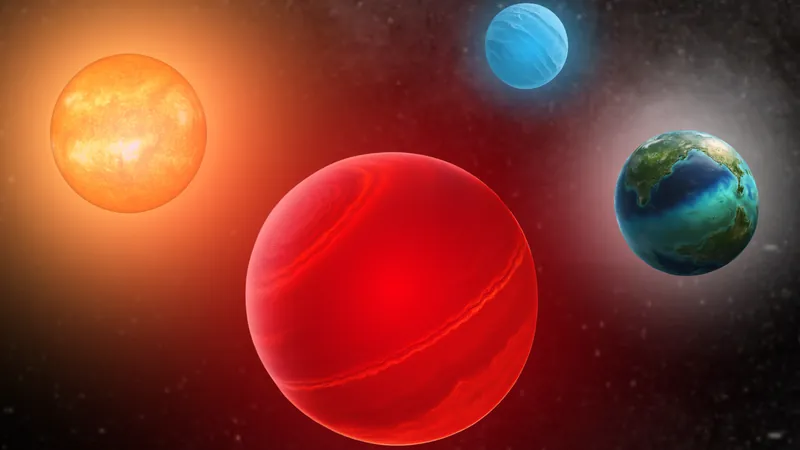
Shocking Discovery in Multi-Planet System Challenges Hot Jupiter Norms!
2025-01-15
Author: Li
Introduction
In a groundbreaking revelation, astronomers have unearthed an unusual multi-planet system that suggests the notorious “hot Jupiter” planets may not be the isolated celestial behemoths they were presumed to be. This discovery might just upend existing paradigms regarding planetary formation and the evolution of planetary systems.
System Overview
Centered around the K-type star WASP-132 and located approximately 403 light-years away in the constellation of Lupus, this system hosts an intriguing trio of planets: the hot Jupiter WASP-132b; a newly identified inner super-Earth, WASP-132c; and an outer ice giant, WASP-132d.
Research Collaboration
The findings emerged from a collaborative research effort involving institutions like the University of Geneva, the National Center of Competence in Research (NCCR) Planets, and the Universities of Bern and Zurich. With a mass just under half that of Jupiter, the hot Jupiter orbits its star in a rapid seven Earth days. Meanwhile, the super-Earth, having around six times the mass of our home planet, makes its orbit in a fantastically swift 24 hours. The distant ice giant, boasting five times the mass of Jupiter, takes a leisurely five years to complete its orbit.
Historical Context
Research on this enigmatic system has been ongoing since 2006 under the Wide-Angle Search for Planets (WASP) program. It was NASA's Transiting Exoplanet Survey Satellite (TESS) that clinched the discovery of the super-Earth in 2021, leading scientists to re-evaluate the potential of the WASP-132 system. Despite nearly two decades of scrutiny, this system continues to surprise.
Expert Insights
As University of Zurich astronomer Ravit Helled remarked, “This discovery reminds us of the exceptional diversity of planetary systems and highlights the many unanswered questions regarding planet formation and the early evolution of young systems.”
Challenge to Conventional Wisdom
So, what exactly sets this system apart? Typically, hot Jupiters—massive gas giants that orbit perilously close to their stars—are thought to become “lonely” due to their inward migration from where they initially formed. This inward movement is suspected to destabilize or annihilate any nearby planets, leading to their reputation as solitary giants. Helled noted, “We believe hot Jupiters start at large distances from their stars and migrate inward, a process that may cause the accretion of material or the ejection of young planetary bodies.”
New Findings
However, the presence of the super-Earth closer to the star than its hot Jupiter counterpart challenges the conventional theories about hot Jupiter formation. The existence of an outer ice giant further complicates the dynamic, indicating that planets can indeed form in proximity to a hot Jupiter. Surprisingly, the stable orbits of these worlds suggest that the migration of WASP-132b may not be as disruptive as previously believed, paving the way for a potentially less chaotic migration pathway.
Future Research Directions
This discovery raises the stakes for planetary science; researchers now seek to understand why the WASP-132 system diverges from the norm of lonely hot Jupiters. “Our next steps involve exploring theoretical models of how such systems could form, as well as examining how prevalent these multi-planet systems featuring a hot Jupiter might be,” Helled explained.
Conclusion
In a universe full of secrets and enigmas, this unexpected planetary arrangement provides a glimpse into the complexities of celestial formation, pushing scientists to reconsider their understanding of the cosmic dance between stars and planets. Will further explorations reveal even more multi-planet systems that defy the odds? One thing is for sure: the search for answers is more thrilling than ever!

 Brasil (PT)
Brasil (PT)
 Canada (EN)
Canada (EN)
 Chile (ES)
Chile (ES)
 Česko (CS)
Česko (CS)
 대한민국 (KO)
대한민국 (KO)
 España (ES)
España (ES)
 France (FR)
France (FR)
 Hong Kong (EN)
Hong Kong (EN)
 Italia (IT)
Italia (IT)
 日本 (JA)
日本 (JA)
 Magyarország (HU)
Magyarország (HU)
 Norge (NO)
Norge (NO)
 Polska (PL)
Polska (PL)
 Schweiz (DE)
Schweiz (DE)
 Singapore (EN)
Singapore (EN)
 Sverige (SV)
Sverige (SV)
 Suomi (FI)
Suomi (FI)
 Türkiye (TR)
Türkiye (TR)
 الإمارات العربية المتحدة (AR)
الإمارات العربية المتحدة (AR)